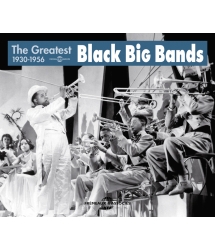The big bands of the thirties and forties tend to interest blues lovers either because of their use of the blues and boogie-woogie formats, often with big, shouting vocalists, or because many of their members later went on to become stars of r&b. This double CD set includes examples from both categories (though there are no blues shouters as such), plus of course, many excellent straight jazz performances – here though I will cherry-pick the bluesier items for review. The use of alphabetical order places Count Basie and his always bluesy band close to the start of the programme, with ‘Basie Strides Again’ a frantic performance that certainly foreshadows r&b. This is ironically the bluesiest of the Count’s three offering here – ‘ironically’ as the other two both have the word ‘blues’ in their titles. Cab Calloway introduces his new trumpeter Jonah Jones with the jive-y ‘Jonah Joins The Cab’, whilst his other title is a fairly straight cover of Duke Ellington/Billy Strayhorn’s ‘Take The A Train’. Benny Carter sounds midway between Glenn Miller (shades of ‘In The Mood’) and r&b on ‘Slow Freight’; ditto with ‘Okay For Baby’, and Carter’s alto solo on this one is very bluesy indeed. Lionel Hampton and his orchestra is represented by ‘Flyin’ Home’ numbers one and two recorded for V-Discs (hence the well over four minutes length of both) and featuring saxmen Arnett Cobb on the first version and Al Sears on the second – some definite honking of the former! Pianist Milt Buckner also makes a telling contribution. Hamp’s two-parter ‘Turkey Hop’ from 1950 is a raunchy, powerhouse piece of big band r&b, no messing! Erskine Hawkins’ band from Alabama is best known for the hits ‘Tuxedo Junction’ and ‘After Hours’ and here they have the bluesy ‘Bicycle Bounce’ and a big band version of ‘Steel Guitar Rag’ (no steel guitar to be heard though!). Fletcher Henderson opens the second disc with some of the oldest titles here, and they do sound quite dated; Earl Hines has his well-known ‘Boogie Woogie On Saint-Louis Blues’ as one of his trio of numbers, and Buddy Johnson’s fine brace (‘Doctor Jive Jives’ and ‘Buddy’s Boogie’) are from 1950 and 1956 respectively. The Kansas City outfits are generally recognised as the bluesiest of the big bands, and the tracks from Andy Kirk, Harlan Leonard, Jay McShann and Bennie Moten (one each) do nothing to dispel that supposition. Jimmie Lunceford’s ‘Uptown Blues’ from 1939 is very aptly titled and sports an excellent alto sax break by Willie Smith, whilst Lucky Millinder’s 1942 ‘Little John Special’ is somewhat of a blaster! Among the numbers and bands not mentioned, there are many performances that will interest readers – the likes of Horace Henderson’s ‘Smooth Sailing’ from 1940 certainly bear some of the characteristics of r&b. Of the musicians who later became well-known in the r&b era and have not already been mentioned, included here are saxmen such as Tab Smith, Eddie ‘Cleanhead’ Vinson, Buddy Tate, Joe Thomas, Earl Bostic, Paul Bascomb, trumpeters Dud Bascomb and Joe Morris, pianist Bill Dogget, long-time Johnny Otis sideman trombonist George Washington, and drummer Jesse Price. Off the top of my head, other peripheral names that crop up in the blues discographies include sax players Johnny Board, Harold Minerve and Ted McRae (of ‘Mr. Bear’ fame), and trombonist John Ewing. As an introduction to the music of the big band era most likely to appeal to readers of this magazine, this is near to ideal. A few more vocal numbers might have improved the selection that is really only a minor quibble and would skew the focus of an admirable release.
Par Norman DARWEN – BLUES & RYTHM
Par Norman DARWEN – BLUES & RYTHM
Produits associés

The Greatest Black Big Bands
CLASSIC JAZZ 1930-1956
29,99 €
19,95 €










